Table of Contents
Transformed into an essential tourist destination, there are many places to visit the United Arab Emirates that captivate visitors with its excess, luxury, and futuristic architecture extravagance. Beyond the opulence, the UAE conceals serene locations boasting breathtaking natural beauty in its vast deserts, stunning beaches, and impressive mountains.
Located on the shores of the Persian Gulf and the Gulf of Oman, bordered by Saudi Arabia and Oman, the United Arab Emirates is a federal state composed of seven emirates. This land is a tapestry of contrasts, featuring mountains and deserts dotted with oases and ultramodern cities. Here, you’ll have the unique opportunity to explore the desert sands in a rugged off-road vehicle or on a camel, or revel in the pleasure of relaxing on the many white sandy beaches with turquoise-blue waters that the country has to offer.
The United Arab Emirates is a federation comprised of seven emirates, each led by a sheikh. The most well-known emirates are Dubai and Abu Dhabi, with the latter serving as the country’s capital.
The other emirates are Ajman, Fujairah, Ras Al Khaimah, Umm Al Quwain, and Sharjah. Among these, only Sharjah boasts a considerable population, nearing two and a half million residents, coming close to Abu Dhabi.
The union of these emirates resulted from the region’s withdrawal from the United Kingdom in the mid-1960s. The political vulnerability of the emirates became apparent, with Iran and Saudi Arabia threatening the territories’ sovereignty. The solution was the formation of the UAE, which at the time also included Bahrain and Qatar, but these two later separated from the UAE in 1971.
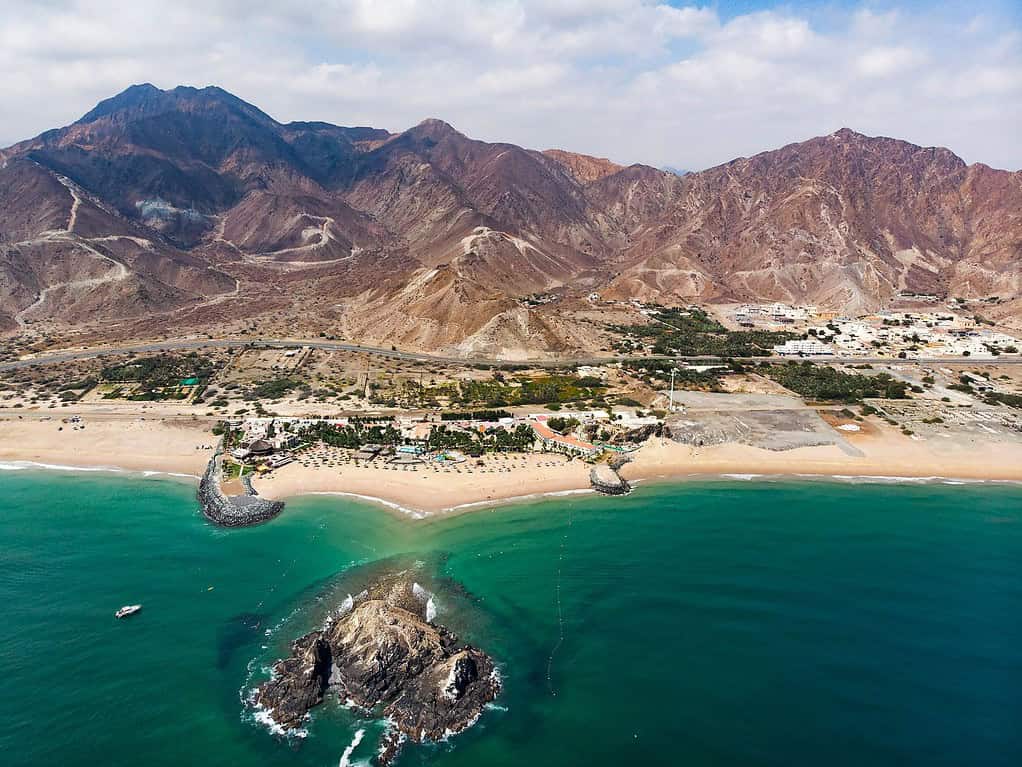

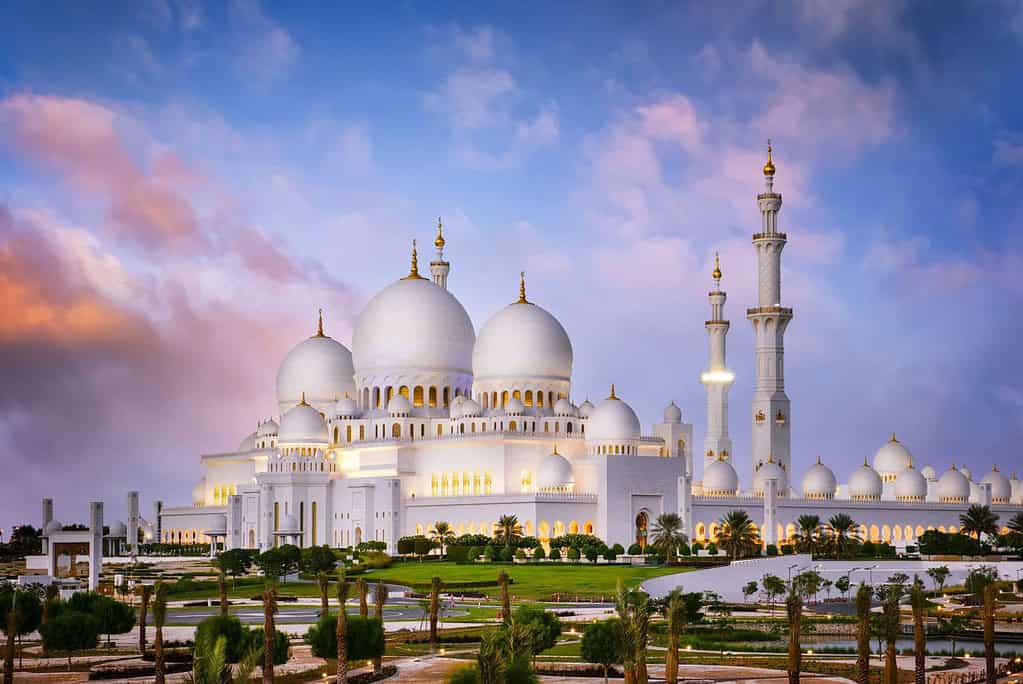
The United Arab Emirates is an exotic country, considered one of the most liberal Islamic nations and one of the most economically stable, though not without its contradictions. In terms of demographics, the population of the UAE is 9.2 million, but only 1.4 million are citizens. The rest of the population comprises immigrants.
To visit this arid country, travelers are encouraged to plan their trip thoroughly before heading to the United Arab Emirates. To immerse yourself in this culture so different from our own in a tranquil manner, it is essential to gather adequate information about its history, geography, how to reach the destination, accommodations, and more, ensuring you enjoy your journey to the fullest.
The Seven Emirates
The United Arab Emirates is a federation composed of seven emirates. Click on the image to open a larger view.
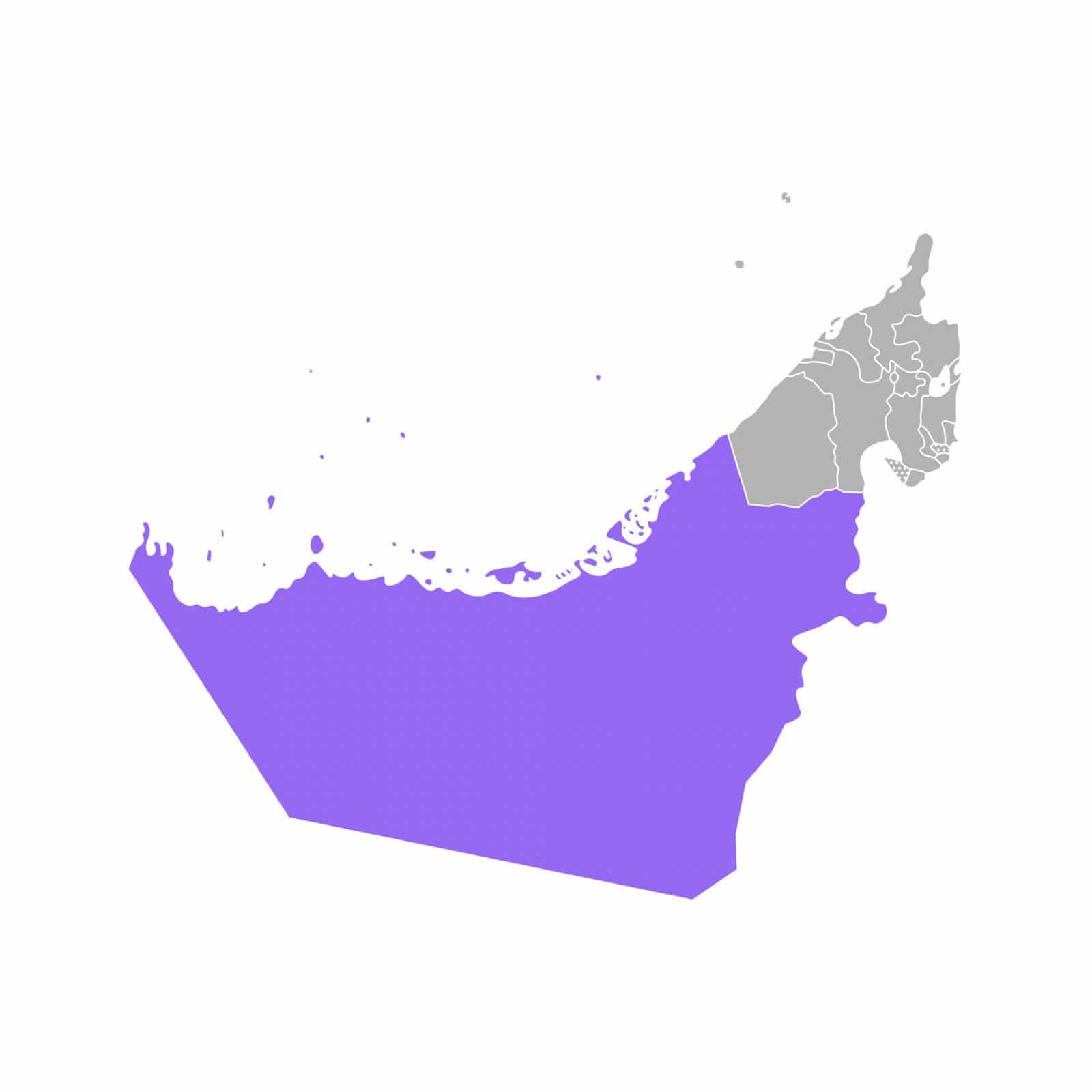
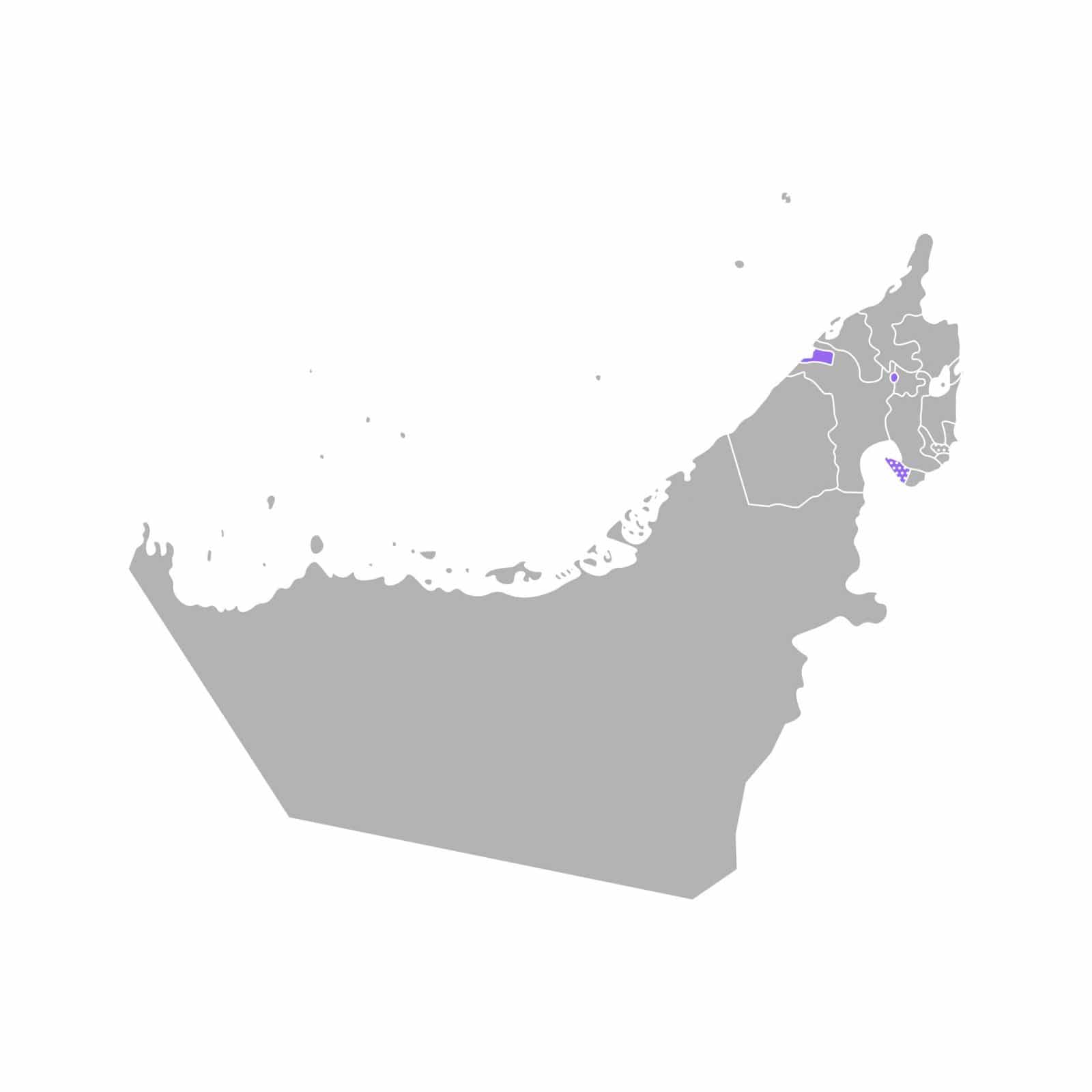
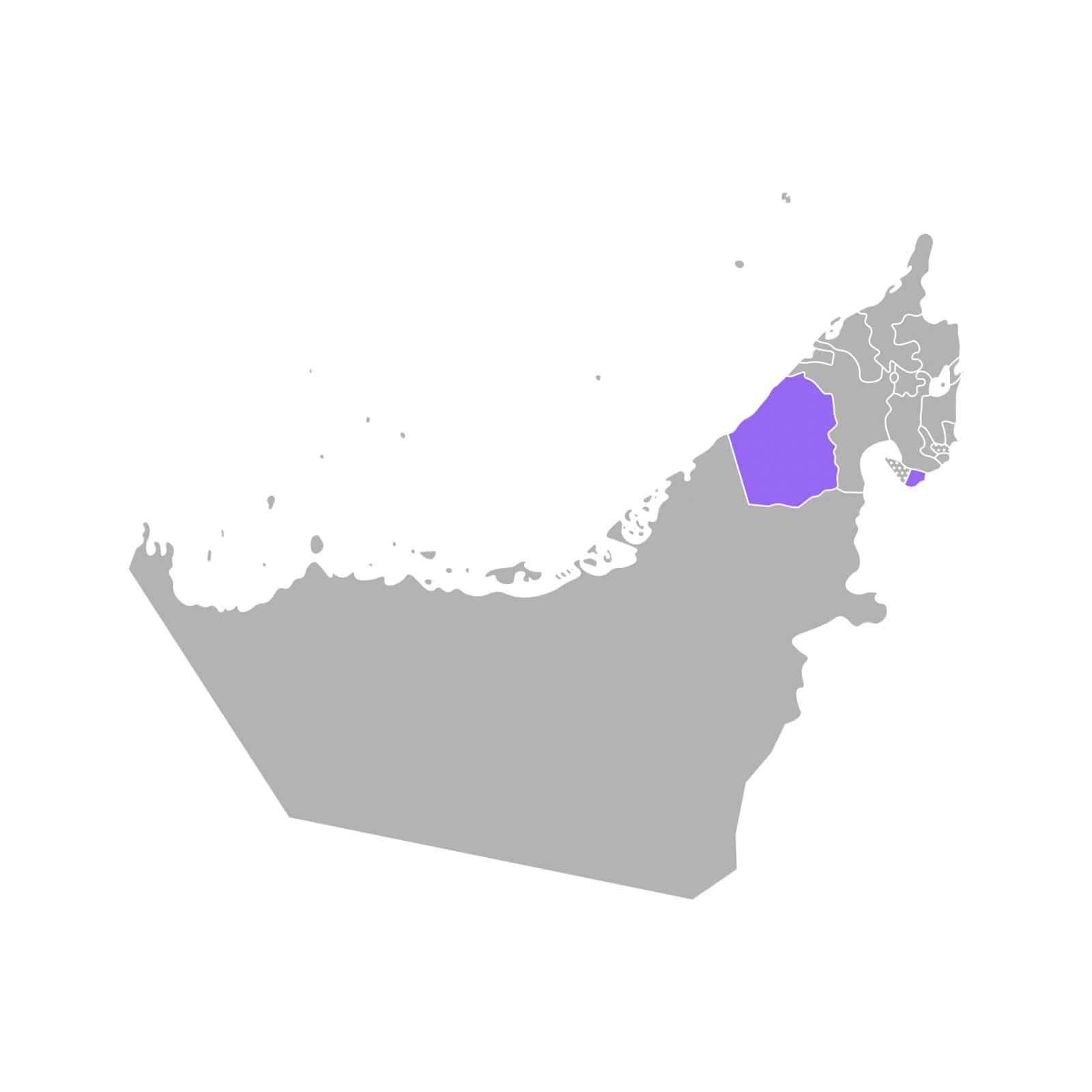
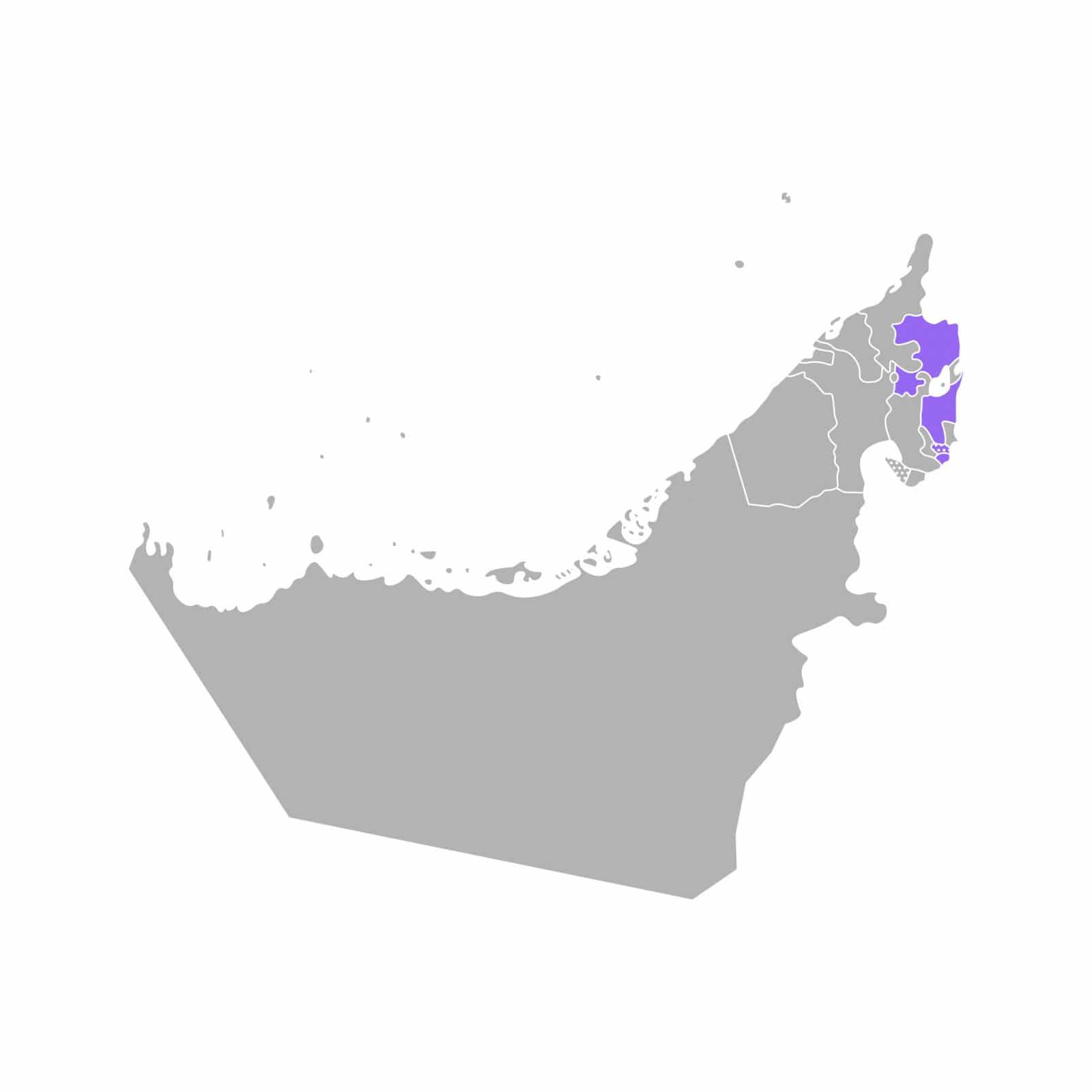
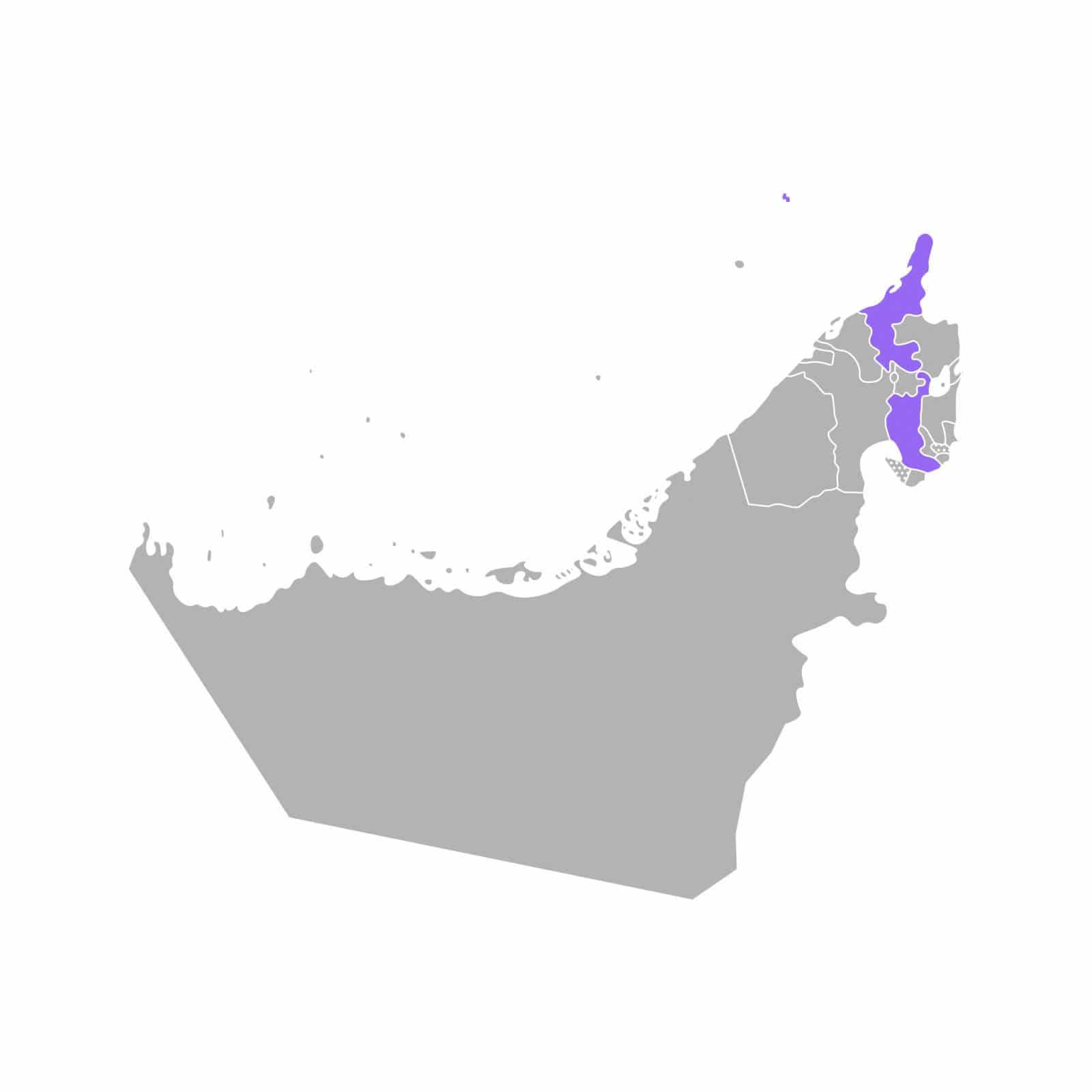
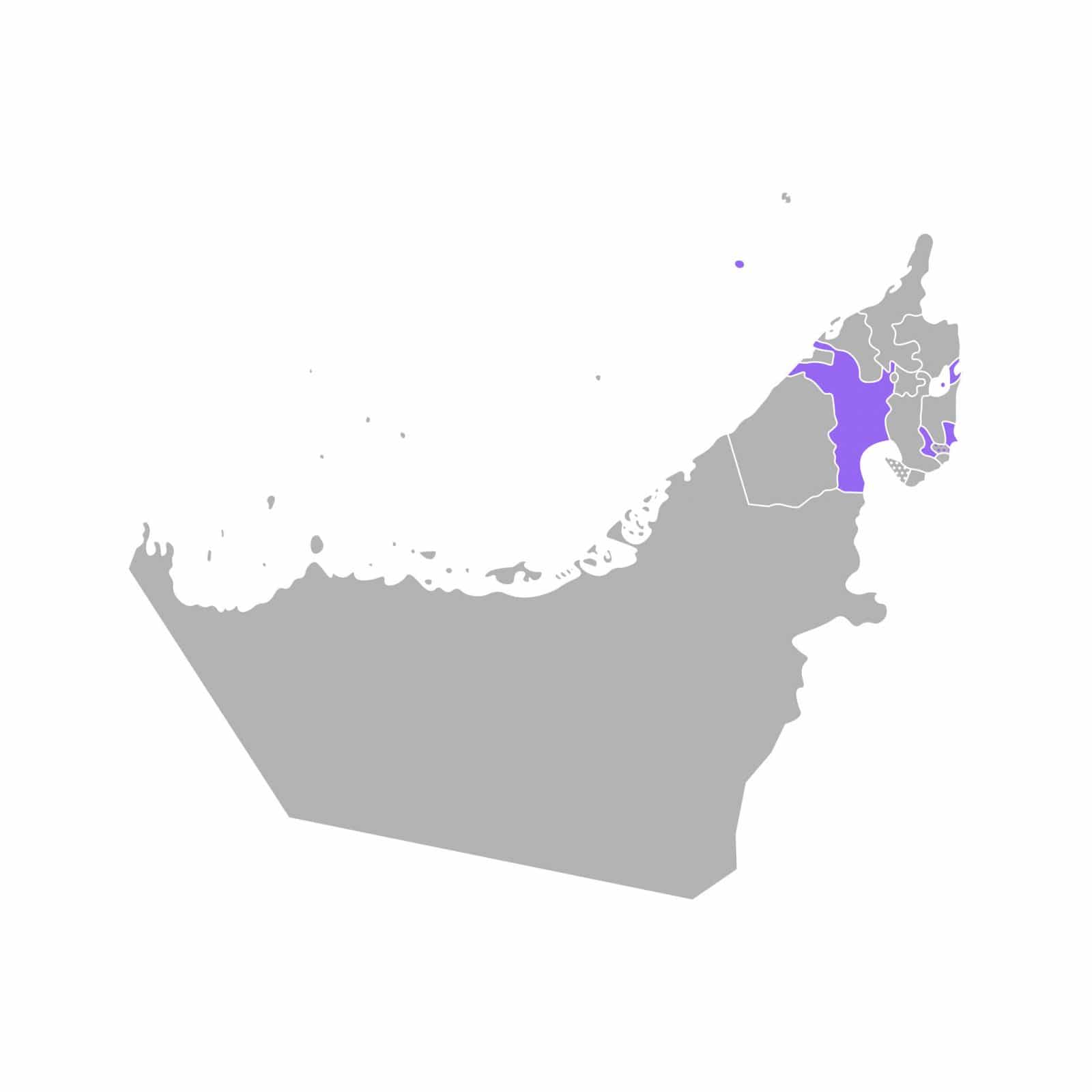
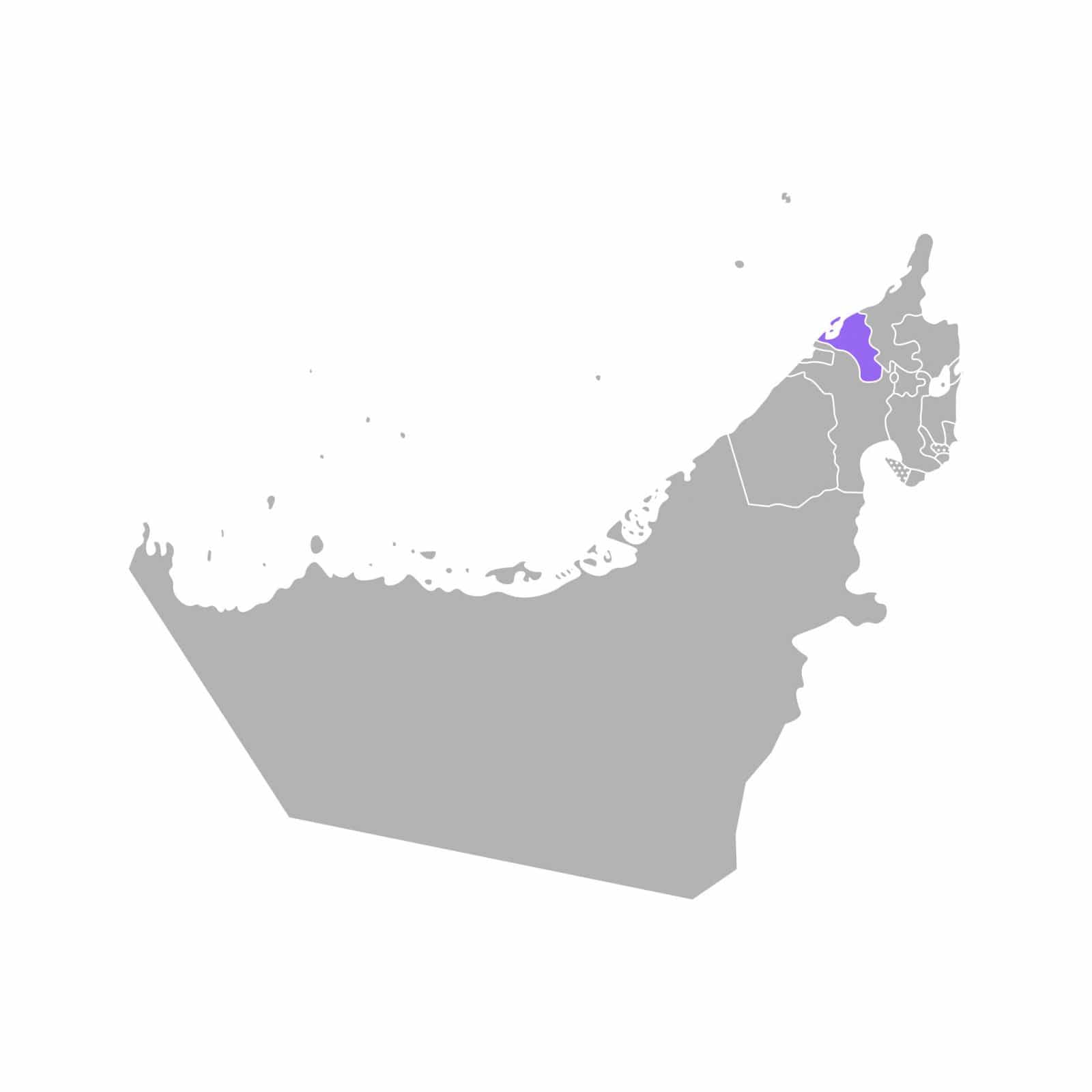
Visit the United Arab Emirates

When you visit the United Arab Emirates it takes you into an incredibly exotic and alluring country, attracting millions of tourists each year who are curious to explore its rich and storied culture.
Who could have imagined this country would become what it is today forty years ago? The United Arab Emirates has become a massive destination for travelers and investors, captivating an entire generation with its unique urban development projects.
Beyond its grand cities, the country boasts several Neolithic archaeological sites that are worth exploring. Not to mention the numerous forts, some over 500 years old, scattered throughout the country. The Al Ain cultural site is the only UNESCO Sites in the UAE.
A vacation in the United Arab Emirates allows you to discover “an ancient people in a modern country.” The United Arab Emirates is a federation composed of seven emirates. The most well-known emirates are Dubai and Abu Dhabi, with the latter serving as the country’s capital. This exotic and extravagant destination offers extraordinary cities and the simplicity of desert landscapes. Come and explore with us!
Map of Tourist Attractions in the UAE
Tour Packages in the Emirates
Embark on an unforgettable adventure with RJ Travel Agency’s wide range of UAE tour packages, from our enticing 3-day Dubai Tour to the comprehensive 8-day Dubai Tour Package. Whether you’re seeking a quick escape or a week-long exploration, we’ve got the perfect journey for you. Not decided yet? Let us guide you to the wonders of the Emirates.
- 3-day Dubai Tour
- 4-day Dubai Package Holidays
- 5-day Dubai Package Tour
- 6-day Dubai Package
- 7-day Dubai Vacation Package
- 8-day Dubai Tour Package
Where to go in the United Arab Emirates
[the-post-grid id=”46598″ title=”Emirates tourist attractions”]
In the United Arab Emirates, you can visit the world’s largest sand dunes located to the south, specifically in Abu Dhabi’s Liwa Oasis area. However, the country also features a wide range of contrasting landscapes, as some opt for the marvelous beaches on the eastern side. A vacation in the United Arab Emirates is always full of surprises!
You’ll find places steeped in history, true archaeological treasures, and magnificent natural rock formations in the Hajar Mountains. These mountains showcase the wild side of this land, with their impressive, towering cliffs offering breathtaking views to those who reach their peaks.
Journeying through the mountainous regions is incredible as roads winding through forgotten and picturesque villages in valleys (wadis) of unique beauty. Consult our map of points of interest in the United Arab Emirates to discover all these incredible places.
This country might give the impression that there isn’t much to do or see, given its arid nature. However, there are truly magnificent and unique travel destinations in the world here, including vast waterfalls with crystal-clear, refreshing waters, as well as stunning cliffs adorned with abundant fossils and freshwater lakes.
The capital, Abu Dhabi, offers two of the country’s main cultural attractions – the grand Sheikh Zayed Mosque and the Louvre Abu Dhabi Museum.
Dubai is the country’s primary tourist destination, boasting modern architecture, towering skyscrapers, beaches, and enormous shopping centers ideal for shopping.
Al Ain is the most relaxed city in the United Arab Emirates and a great place to escape the hustle and bustle of Abu Dhabi or Dubai. In Al Ain, visit the fort, museums, the Hili Archaeological Park, and discover Jebel Hafeet.
Head to Fujairah to visit its coastal forts and the beautiful Al Bidya Mosque. If you want to explore beach resorts beyond Dubai, consider visiting Ras Al Khaimah and Ajman.
Ras Al Khaimah is the most popular beach holiday destination in the United Arab Emirates, featuring many hotels in resorts with white sandy beaches.
Ras Al Khaimah also offers more than just beaches. Book a tour of the desert mountains, where you can choose from various adventure activities and excursions around Jebel Jais.
Or head to the white sands of Al-Aqah in Fujairah, where it’s all about snorkeling and beach vacations. The beach resorts of Fujairah, with their diving activities, are among its main attractions.
Don’t miss Sharjah if you’re interested in history or art, as the city is filled with museums and galleries. Sharjah is a must-visit destination for museum enthusiasts and cultural visits. In the beautiful old neighborhood known as the Heritage Village, you can appreciate Sharjah’s restored architectural heritage and the excellent Museum of Islamic Civilization.
Sharjah is served by an international airport (Sharjah International Airport), located 10 km southeast of the city center. The airport is the second-largest cargo air center in the Middle East. If you enjoyed visiting Sharjah’s museums, don’t miss the fabulous Louvre Abu Dhabi.
UAE Travel Guide
Click, to open:
Best Places to Visit Abu Dhabi
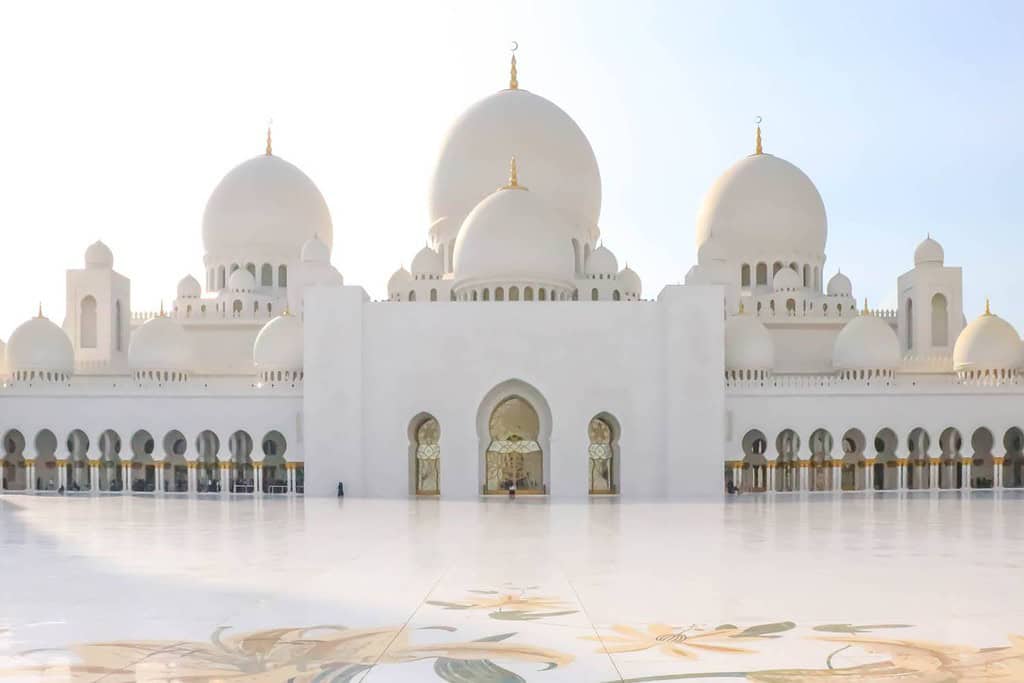
Abu Dhabi is the second most well-known emirate after Dubai and serves as the capital city of the United Arab Emirates. It is home to approximately one and a half million inhabitants.
The city of Abu Dhabi is a modern metropolis, as one would expect, characterized by wide avenues, numerous green spaces, and remarkable contemporary architecture. It was planned in 1967 by the Japanese architect Katsuhiko Takahashi, with an initially modest population target of 60,000 residents, a number that had already doubled by 1975.
As the capital of the United Arab Emirates, Abu Dhabi is well-organized and beautifully situated by the sea. The Sheikh Zayed Grand Mosque is the main tourist attraction in Abu Dhabi. The city also serves as an excellent base for excursions to the Liwa Desert and the city of Al Ain.
Originally inhabited by the nomadic Bani Yas tribe in 1760, Abu Dhabi remained a small fishing village until the discovery of oil. The revenues from “Black Gold” transformed Abu Dhabi into the modern city and bustling center of government and business that we know today.
What to do in Abu Dhabi
Sheikh Zayed Grand Mosque: Covered in Macedonian marble, the stunning Sheikh Zayed Grand Mosque is the landmark building of Abu Dhabi and by far the city’s most popular tourist attraction.
Louvre Abu Dhabi: The most spectacular museum in the Middle East, the Louvre Abu Dhabi traces the history of human artistic achievements from the Neolithic era to modern times.
Kayaking in the mangroves: To see a different side of Abu Dhabi’s steel and glass architecture, explore the mangrove forests that still surround the islands along the city’s coast.
Desert Safari: The most famous day or night excursion departing from Abu Dhabi is a desert safari, either to the beautiful Liwa Oasis on the edge of the grand Rub Al Khali desert or to the Al Khatim desert near Al Ain.
Ferrari World: This Ferrari-themed amusement park brings the excitement of Formula 1 racing to Abu Dhabi and is one of the city’s main attractions.
Heritage Village: Abu Dhabi’s Heritage Village is an authentic replica of a typical Bedouin village, giving visitors an idea of life in the Emirates before the oil boom. The village is located in a beautiful area of the city by the beach.
Boat tours: For the best views of Abu Dhabi’s skyscrapers, take to the water. The views of the skyscrapers are spectacular when seen from the marina. In addition to sunset cruises, there are various boat tours to the bay islands, including beach time, snorkeling, and diving.
Observation platform at 300: Abu Dhabi’s equivalent to Dubai’s Burj Khalifa is this observation deck, offering stunning views from the city’s highest point, on the 74th floor of the Jumeirah at Etihad Towers hotel.
Qasr Al-Hosn: The recently restored Al-Hosn Fort, also known as the Old Fort or White Fort, is the oldest building in Abu Dhabi and one of its main historical points of interest. The palace was built in 1793 as the residence of the ruling family and the seat of government.
Abu Dhabi Falcon Hospital: The Abu Dhabi Falcon Hospital is a veterinary hospital that cares for sick and injured falcons but also offers guided tours of its facilities to interested visitors.
Yas Island: Yas Island is one of Abu Dhabi’s top luxury hotel destinations, with stretches of perfect beaches for sunbathing all day. On Yas Island, you’ll also find the Yas Marina Formula 1 Circuit, Yas Mall (the city’s main shopping destination), and Warner Bros. World.
Sir Bani Yas Island: One of the best nature tours from Abu Dhabi is the Sir Bani Yas Island wildlife reserve. Arabian wildlife, such as gazelles and Arabian oryx, roam freely within the vast reserve, which covers the island’s interior.
Best Places to Visit Dubai
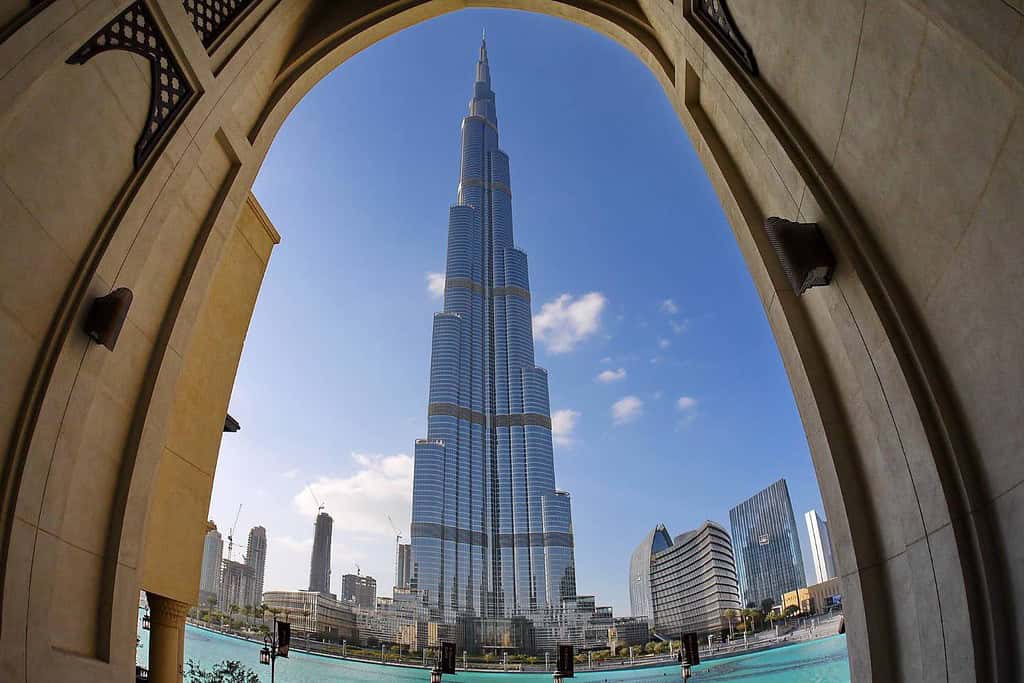
Dubai is an emirate and also a city, often mistaken as its name suggests. If you’re wondering which country Dubai is located in, then you now know the answer. Although it is not the largest emirate, and the city is not the capital of the United Arab Emirates.
The collective imagination maintains an image of Dubai based on modernity, extravagance, luxury, and high prices. All these attributes are indeed present, and Dubai acts as a beacon attracting citizens from neighboring countries who seek forbidden pleasures in their homelands.
There’s always plenty to do in Dubai, as the city boasts a vibrant tourism industry, with realities that have emerged from investments made with oil money from the emirate.
But Dubai is more than that. It’s true that the city’s glamour is the major draw for most visitors, but those who wish to delve deeper will find different facets of the city. The citizens of the emirates benefit from a social security system that practically allows them to live without working.
Even socially, there aren’t many jobs considered acceptable: high-level business, public service, and security forces. This means that the country depends on immigrants to function, and the presence of these vast communities, mostly underpaid individuals living in precarious conditions, adds another layer of depth to the city.
What to do in Dubai
Heritage Village: Inaugurated in 1997 in the prestigious district of Al Shindagha. Originally, the village served as a historic heritage site, offering visitors a glimpse into the traditional Emirati way of life. Here, you can explore authentic replicas of ancient homes and watch skilled artisans demonstrate traditional crafts. Immerse yourself in the rich history and culture of the United Arab Emirates as you wander through this captivating village.
Miracle Garden: Boasts an astounding display of 45 million flowers. However, during the scorching summer months, the garden is temporarily closed due to the extreme heat. When in bloom, this garden transforms into a breathtaking spectacle of vibrant colors and intricate floral designs. It is a paradise for nature lovers and a perfect place to take in the beauty of nature’s wonders.
Dubai Creek: A place where modernity seems to have not yet arrived. This historical waterway divides the city into two parts, Deira and Bur Dubai. Take a boat ride along the creek to witness the mesmerizing blend of the old and new Dubai. The area near the creek, particularly around the bustling souks, offers a glimpse into the city’s trading past, making it a must-visit for history enthusiasts.
Dubai Mall: Is the largest shopping center in the world, houses an impressive 1,300 stores. Located in the heart of the modern city, it offers an unparalleled shopping experience. Beyond its retail allure, the mall features numerous entertainment options, such as an ice-skating rink, a giant indoor waterfall, and an indoor theme park. Whether you’re a shopaholic or a leisure seeker, Dubai Mall has something to offer everyone.
Beaches in Dubai: Dubai boasts a selection of beautiful beaches, making them ideal destinations during the hot summer months. The pristine shores and crystal-clear waters offer the perfect escape for beachgoers seeking relaxation and fun. Enjoy a variety of water sports, beach activities, and beachfront dining options at these idyllic spots along the Arabian Gulf.
Jumeirah Mosque: Regarded as one of Dubai’s most beautiful mosques, Jumeirah Mosque stands as an architectural masterpiece. Unlike many other mosques in the United Arab Emirates, Jumeirah Mosque is open to non-Muslim visitors, providing an opportunity for cultural exchange and understanding. Guided tours offer insights into Islamic traditions and beliefs, making it a fascinating experience for all visitors.
Al Fahidi Historical Neighborhood: Although not very large, a visit to the Al Fahidi Historical Neighborhood is essential. This historic area showcases the visible core of old Dubai, featuring traditional wind-tower houses, narrow alleys, and charming courtyards. The Dubai Museum, located in Al Fahidi Fort, offers a fascinating journey through the city’s transformation from a fishing village to a global metropolis.
Dubai Marina: A leisurely walk along Dubai Marina promises an interesting experience. As the largest artificial marina in the world, it is surrounded by impressive skyscrapers and luxury yachts. Enjoy the vibrant atmosphere, dine at waterfront restaurants, or simply take in the stunning views of modern Dubai against the backdrop of the sparkling marina.
Dubai Museum: Located in the historical core, the Dubai Museum is the primary museum of the emirate. Housed in Al Fahidi Fort, which dates back to the 18th century, the museum presents exhibits on Dubai’s history, culture, and traditions. Learn about the city’s transformation and gain insights into the lives of early settlers and traders in this captivating museum.
Dubai Fountain: Elaborate complex of lakes adorned with fountains that project water jets illuminated by colorful lights, creating a mesmerizing dance. The fountain show is accompanied by music, making it a captivating visual and auditory experience. Visit the Dubai Fountain in the evenings to witness the enchanting displays set against the backdrop of the iconic Burj Khalifa.
Dubai Aquarium: Features an immense tank with approximately ten million liters of water, home to a diverse array of marine life. Stroll through the underwater tunnel and get up close to sharks, rays, and other fascinating sea creatures. The aquarium offers educational experiences and thrilling encounters with marine wildlife, making it a favorite destination for families and nature enthusiasts.
Burj Khalifa: It is currently the tallest building in the world, and it stands as the most iconic element of Dubai’s skyline. Aside from its remarkable height, the Burj Khalifa offers an observation deck on its 148th floor, providing breathtaking panoramic views of the city. Visit this architectural marvel and witness Dubai from new heights.
Best Places to Visit Sharjah
Known as the “Museum City” of the United Arab Emirates, Sharjah has favored low-rise buildings over skyscrapers, setting it apart from its neighboring emirates.
Located north of Dubai, Sharjah is the cultural capital of the UAE, preserving a significant heritage area. The city boasts well-restored houses and museums, especially dedicated to showcasing the country’s customs. Notable among them is the famous Fort, once a royal residence in the 19th century.
Situated along the southern coast of the Persian Gulf, Sharjah offers breathtaking panoramic views and a vibrant cultural life. As the third-largest city in the United Arab Emirates, Sharjah plays an integral part in the Dubai-Sharjah-Ajman metropolitan area.
If you have an interest in history or art, Sharjah is a must-visit destination, as it is teeming with museums and galleries. The city offers an enriching experience for museum enthusiasts and culture seekers alike.
What to do in Sharjah
City of Sharjah: The vibrant city offers a blend of modernity and cultural richness, with various attractions and landmarks.
City of Khor Fakkan: This picturesque city is known for its stunning landscapes and tranquil beaches.
Big Read and Pink Rock: These unique geological formations are popular natural landmarks worth exploring.
Fort of Sharjah: A historical fortress that provides insights into the emirate’s past.
Heritage District: The charming Heritage Village showcases the restored architectural heritage of Sharjah, while the excellent Museum of Islamic Civilization offers a deeper understanding of Islamic culture.
Souq Al Markazi: This central market offers an authentic Arabian shopping experience.
Sharjah Art Museum: A must-visit for art enthusiasts, this museum houses an impressive collection of modern and contemporary art.
Best Places to Ajman
Ajman City is the capital of the small emirate of Ajman in the United Arab Emirates. As the main center of the emirate, more than 90% of the population lives in this city.
Ajman is just 15 minutes away from Sharjah International Airport, 30 minutes from Dubai International Airport, and a little over two hours from Abu Dhabi International Airport.
Ajman, with its beaches, mangroves, museums, and shopping centers, offers an interesting blend to attract travelers of all ages.
In Ajman, you can visit the Ajman National Museum, located within an old fortress.
Masfout is known for its fertile farmlands and high-quality marble and is located in the southern part of the United Arab Emirates, near Hatta, a 90-minute drive from the city of Ajman.
Located on the plains at the foot of the Hajar Mountains, east of Ajman, Manama is approximately an hour’s drive from the city center.
What to do in Ajman
Ajman Fort: Built in the late 17th century, is made of coral stones, plaster, and tree trunks from East Africa. The fort was destroyed by the English in the early 19th century and later rebuilt by Sheikh Rashid Bin Humaid.
Masfout: Located 110 km southeast of Ajman, this enclave is notable for its natural and historical heritage. In the heart of the mountains, you’ll find peaks like Dafta, Madeerah (the famous White Mountain), Leshan, and Abu Faraj. Not to be missed are the towns of Sasfout and the small centers of Mzairea and Sabeigah. The area is rich in vegetation, extending to the border with Oman. The rocky valleys are also incredible, such as Ghalfa, Leshan, Al-Sawamir, Al-Khanfarih, and Al-Dafdi. The climate is milder than the desert, making it an excellent tourist destination during the summer.
Al Manama: Situated in the heart of the desert and close to the Al-Ashqar and Bin Elwah Mountains. The centerpiece of Al Manama is the ancient fort surrounded by beautiful magnesite and chrome mountains. Perched on a hill overlooking the plains of Manama, the Hassa Buweid Castle was built as a fortress by Sheikh Rashid bin Humaid Al Nuaimi. There is also the Museum of Manama, located inside a beautiful white fortress. The Al Manama Museum mainly highlights the region’s heritage, traditional architecture, and local crafts.
Best Places to Visit Umm Al Quwain
Umm Al Quwain is one of the lesser-known emirates of the United Arab Emirates.
Located between Sharjah and Ras Al-Khaimah, Umm Al Quwain is still relatively undeveloped for tourism.
With several beautiful white sandy beaches, Umm Al Quwain offers a life away from the tourist frenzy of the other emirates, providing experiences of day-to-day life in small fishing villages.
Not to be missed is the fascinating Umm Al Quwain Fort, or the abandoned Russian cargo plane Ilyushin IL 76.
What to do in Umm Al Quwain
Umm Al Quwain Fort: Also known as Al Ali Fort, is a historical landmark that holds rich cultural significance for the emirate. Built in the 18th century, this ancient fortress stands as a testimony to the region’s past and offers a glimpse into its intriguing history. With its traditional architecture, thick walls, and watchtowers, the fort served as a defensive stronghold and residence for the ruling Al Ali family.
Visitors can explore the well-preserved interior, which houses exhibits and artifacts related to the local heritage and maritime history. From the top of the fort, one can enjoy panoramic views of the surrounding landscape, including the nearby mangroves and the shimmering waters of the Gulf.
Russian Cargo Plane: An intriguing sight to behold in Umm Al Quwain is the abandoned Russian cargo plane, an Ilyushin IL-76, that rests in the desert. This fascinating relic serves as a reminder of the area’s past connections with the aviation industry. Once part of the Soviet cargo fleet, the plane’s mysterious presence in the desert has become an attraction for curious explorers and aviation enthusiasts.
Umm Al Quwain Island: Also known as Sinniyah Island, is a natural treasure nestled in the emirate’s waters. Offering a serene escape from the bustling mainland, the island is a haven for nature lovers and those seeking a relaxing retreat. The pristine sandy beaches, crystal-clear waters, and swaying palm trees create a picturesque setting for beachgoers.
Visitors can indulge in various water activities such as swimming, snorkeling, and beachcombing. Exploring the island’s mangrove forests and bird-watching spots is also a popular attraction. For a truly unforgettable experience, witnessing the stunning sunsets over the Gulf from the island’s shores is a must.
Archaeological Site of Ed-Dur: Historical treasure trove that unveils the ancient civilization of Umm Al Quwain. Dating back to the 1st millennium BCE, this site is an archaeological wonder that provides valuable insights into the region’s past. Excavations have revealed a once-thriving trading port, complete with the remnants of buildings, tombs, and artifacts.
Visitors can explore the excavated structures and learn about the culture and lifestyle of the ancient inhabitants. The site’s museum showcases the discovered artifacts, offering a fascinating journey through time. The Archaeological Site of Ed-Dur stands as a testament to the emirate’s rich history and its significance as a trading hub in the past.
Desert and Dunes: The vast desert and undulating sand dunes surrounding Umm Al Quwain present a captivating landscape that beckons adventure seekers and nature enthusiasts alike. Embarking on a desert safari or a dune bashing excursion is an exhilarating way to experience the untamed beauty of the desert.
Best Places to visit Ras Al Khaimah
The northernmost region of the United Arab Emirates is known as Ras Al Khaimah.
This emirate is nestled at the foot of the impressive Hajar Mountains, which dramatically descend to the coastline, making it an excellent base for exploring and trekking through the mountains.
Ras Al Khaimah holds significant historical importance, with archaeological excavations revealing human habitation in the region since the third millennium BCE.
A visit to the Ras Al Khaimah National Museum offers a fascinating insight into the emirate’s human history.
What to do in Ras Al Khaimah
Dhayah Fort: Perched atop a rocky hill, Forte Dhayah stands as a symbol of Ras Al Khaimah’s resilience and historical significance. Dating back to the 19th century, this well-preserved fort offers captivating views of the surrounding landscape and the Arabian Gulf. Forte Dhayah played a pivotal role in the region’s defense against invaders, and visitors can explore its strategic layout, ancient artifacts, and informative exhibits that provide insight into the emirate’s past.
National Museum: The National Museum of Ras Al Khaimah invites visitors to embark on a journey through time, tracing the emirate’s rich history and cultural heritage. Housed within an impressive fort, the museum showcases a diverse collection of artifacts, ancient manuscripts, traditional crafts, and archaeological findings. Exhibitions highlight the region’s development, from prehistoric times to modern achievements, making it a compelling destination for history enthusiasts and those curious about Emirati culture.
Al Jazirah Al Hamra: Stepping into Al Jazirah Al Hamra feels like entering a living history book. This well-preserved heritage village offers a glimpse into the traditional Emirati way of life. Explore the narrow lanes, mud-brick houses, and charming wind towers that once sheltered the local community. A stroll through this historic site evokes a sense of nostalgia, and the village serves as a reminder of the emirate’s cultural roots.
Jebel Jais Mountain: For nature enthusiasts and adventure seekers, Jebel Jais Mountain presents an awe-inspiring playground. As the highest peak in the United Arab Emirates, Jebel Jais offers a refreshing escape from the desert landscape. Visitors can embark on scenic drives or thrilling hikes to the summit, where they are rewarded with panoramic vistas of rocky cliffs and deep valleys. The cooler temperatures at the mountain’s peak make it an ideal spot for camping, picnicking, or simply savoring the breathtaking scenery.
Hajar Mountains: Natural marvel that runs through Ras Al Khaimah, adding a touch of rugged beauty to the emirate’s landscape. This mountain range offers outdoor enthusiasts a wealth of opportunities for adventure. Hiking trails wind through stunning wadis and terraced villages, offering an unforgettable journey through lush oases and captivating vistas.
The Hajar Mountains are also renowned for their therapeutic hot springs, inviting travelers to relax and rejuvenate in nature’s embrace. Whether it’s exploring the mountains’ ancient villages, marveling at the geological wonders, or simply reveling in the tranquility, the Hajar Mountains provide a unique and memorable experience in Ras Al Khaimah.
Best Places to Visit Fujairah
Fujairah is a modern city with a touch of industry, serving as the primary urban center on the east coast of the United Arab Emirates. The emirate is distinctively separated from the rest of the country by the majestic Hajar Mountains, forming a dramatic backdrop to its landscape. The northern beaches of Fujairah boast some of the most beautiful shores in the UAE, making it an ideal destination for sunbathing, swimming, and diving.
In addition to its contemporary allure, Fujairah proudly preserves its rich historical heritage. The city is dotted with ancient landmarks and points of interest, inviting visitors to explore its storied past. Among the historical gems are several centuries-old forts, each telling tales of the region’s fortitude and fortification. Notably, Fujairah houses the country’s oldest mosque, the Al Badiyah Mosque, a remarkable testament to its enduring cultural roots.
The Emirate of Fujairah’s unique blend of modernity and historical charm, complemented by its scenic landscapes, makes it a captivating destination for travelers seeking both cultural enrichment and outdoor adventures.
What to do in Fujairah
Fujairah Fort: Overlooking the city, the Fujairah Fort stands tall as a symbol of the emirate’s past and resilience. Dating back to the 16th century, this historic fortress offers panoramic views of the surrounding landscape and the Gulf of Oman. The Fujairah Fort is an essential stop to delve into the emirate’s history and enjoy its scenic vistas.
Western Hajar Mountains: The Hajar Mountains adorn the horizon with their rugged charm and pristine beauty. The western part of these mountains is accessible from Fujairah, inviting visitors to embark on adventurous treks, explore enchanting wadis, and immerse themselves in nature’s embrace. The majestic Hajar Mountains offer a refreshing escape from the city’s bustle and are a haven for outdoor enthusiasts and nature lovers.
Al Badiyah Mosque: The oldest mosque in the United Arab Emirates. This historical treasure dates back to the 15th century and offers a glimpse into the region’s religious and architectural heritage. Visitors can admire the simple yet captivating design of the mosque and appreciate its cultural significance.
Fujairah Museum: For those intrigued by the emirate’s history and culture, the Fujairah Museum is a must-visit destination. Housed within a renovated fortress, the museum showcases a diverse collection of artifacts, archaeological findings, and traditional crafts. It offers an immersive experience, guiding visitors through Fujairah’s evolution from its early days to its present-day achievements.
Heritage Village: Fujairah’s Heritage Village presents an authentic glimpse into the emirate’s traditional way of life. The village showcases a reconstructed ancient settlement, complete with traditional houses, handicraft workshops, and cultural exhibitions. It offers a unique opportunity to immerse oneself in the Emirati heritage and experience the customs and traditions of the past.
What to do in the United Arab Emirates
Activities
The beaches are the main draw for tourists, offering excellent features for enjoying the beach season: fine white sands, scorching climates, and clear waters with pleasantly warm temperatures. Some take advantage of these waters for snorkeling or diving, especially on the Eastern Coast.
In Dubai, you can also go skiing at the indoor Ski Dubai Resort, for example.
Considered one of the world’s most advanced ski resorts, everything is prepared for you here as a skier – skis, snowboards, snowsuits, boots, socks, gloves, etc. – you just arrive and enjoy the adrenaline rush.
Another thrilling activity is the 4×4 Jeep tours in the desert, where you can receive some preliminary lessons on driving in the sand. Depending on your chosen experience, you may also take a camel ride in the desert, ending with an Arabian buffet accompanied by belly dancers.
Architecture
The architecture of the United Arab Emirates is among the most impressive highlights, with structures that are simply magnificent – boasting unique and exotic architectural designs, sometimes even surreal, leaving a lasting impression on any tourist.
One of the most famous buildings is the Burj Khalifa, the tallest in Dubai and the world, offering a breathtaking panoramic view for those brave enough to reach its top floor.
The exquisite Sheikh Zayed Grand Mosque, adorned with materials like gold, glass, and marble, showcases a design that respects traditional architectural concepts, merging with an extremely contemporary style.
Other buildings you shouldn’t miss include the humble yet beautiful Al-Bidyah Mosque, the Sharjah Art Museum – the most important art museum in the United Arab Emirates, constantly displaying the most beautiful works of Arab artists; the Sharjah Museum of Islamic Civilization, where you can explore the lives and cultures of ancient civilizations; and the Dubai Museum, located within the Al-Fahidi Fort.
Shopping
When people don’t come to the United Arab Emirates for beach vacations, many use it as a shopping hub, offering products not found anywhere else in the world.
The United Arab Emirates boasts massive streets filled with luxury stores featuring brands such as Dior, Chanel, or Louis Vuitton, just a few examples of the extensive commercial landscape here.
I hope this translation captures the informative, motivating, and inspiring vibe you were looking for. If you need any further translations or have any specific requests, feel free to ask!
Best Time to Visit the United Arab Emirates

The United Arab Emirates has a desert climate, characterized by mild winters and extremely hot summers, with the humidity from the Persian Gulf making the heat unbearable. As good weather is essential for the success of your trip, we have condensed most of the weather information into a practical guide for you. Temperatures, rainfall, sunlight, etc.
The temperature and climate in the United Arab Emirates are generally hot and dry. Temperatures range from around 15°C to 21°C in the coldest season, while in the summer, they can soar between 32°C to 46°C.
- December to February are the best months to visit. During this time, you’ll find ideal temperatures during the day, ranging from 20 to 25 degrees, with some cooling at night, where the thermometers can drop to around 10 degrees.
- From May to October, the heat becomes extremely intense, and only those most resistant to high temperatures will feel comfortable exploring outdoor spaces.
- During the remaining months, it will still be hot, but within comfortable levels for most people.
- The average sea water temperature throughout the year is 27°C, ranging from a minimum of 21°C in January to a maximum of 33°C in August.
The majority of tourists arrive in the UAE during the winter months (November to April). During this period, the average sea water temperature at Dubai’s beaches is 23°C, which most people will find pleasant.
- January – March: These are some of the best months to visit, with average high temperatures ranging from 24°C (75°F) to 29°C (84°F).
- April – May: The weather starts to get hotter, with highs reaching up to 38°C (100°F).
- June – September: These are the hottest months, with average high temperatures reaching above 40°C (104°F). Sometimes, temperatures can even reach 48°C (118°F). These are generally considered the worst months to visit if you want to avoid extreme heat.
- October – December: The weather begins to cool down again, with high temperatures ranging from 35°C (95°F) down to 26°C (79°F). These months are also generally good for travel.
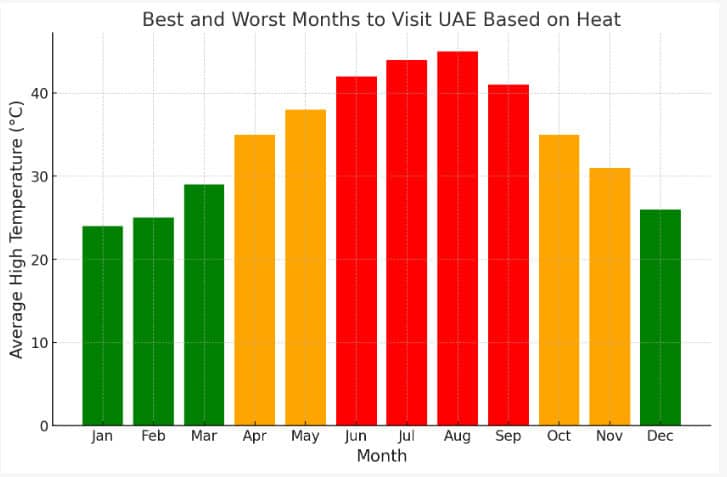
The bar chart above represents the average high temperatures in the United Arab Emirates (UAE) for each month of the year. The temperatures are represented in Fahrenheit.
- The months highlighted in green (January, February, March) are the best months to visit UAE, with the most comfortable temperatures.
- The months highlighted in red (June, July, August, September) are the hottest months and generally considered the worst months to visit if you want to avoid extreme heat.
- The months highlighted in orange (April, May, October, November, December) have intermediate temperatures. They may still be comfortable for some travelers, but they are noticeably warmer than the months highlighted in green.
If you visit the United Arab Emirates during the hot months, be prepared for the low temperatures indoors due to the radical use of air conditioning. Precipitation is minimal throughout the year, ranging from 10 to 20 mm per month, and there are no significant variations in the climate besides the temperatures.
Choose the right time to travel to make the most of your vacation in the United Arab Emirates. Get informed about all the weather trends to start your vacation at the best time with our table below.
The challenge we face in the UAE is that being a Gulf country, it is exposed to an extreme concentration of humidity and heat, making it almost unbearable to be outdoors, day or night. In the summer months, the beach water is extremely warm, so you’ll have the air at 45°C, and the beach water at 33°C. It will feel like being a carrot in a pot of soup.
Events and Festivals
The United Arab Emirates hosts religious and cultural celebrations throughout the year.
- In March, there are two major art events – the Abu Dhabi Festival and the Sharjah Biennial – showcasing Arab and international arts.
- Culinary festivals also take place in the territory, such as Gourmet Abu Dhabi or the Taste of Dubai Festival.
- The national holiday is celebrated on December 2nd.
